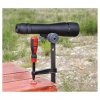I've been looking at the Celestron C90 recently mostly as a telephoto lens but it's actually marketed as a 3 in 1 spotting, telephoto, and astronomical scope. From what I've read it is phenomenal quality for being well south of $200, and a bit of a "sleeper" in that not many people realize this. They don't typically come with a tripod (but the optics planet deal includes one) so you'll have to take into consideration that expense, but in a way that's good so you can get one optimized for what you intend to do with it.
Anyone familiar with these? Are they well known in the shooting community? Is there something lacking in this design for range use as compared to a more conventional spotting scope?
https://www.opticsplanet.com/celest...e-52268-op-90mm-spotting-scope-with-trip.html
https://www.amazon.com/Celestron-52...&qid=1528669157&sr=8-1&keywords=celestron+C90

Anyone familiar with these? Are they well known in the shooting community? Is there something lacking in this design for range use as compared to a more conventional spotting scope?
https://www.opticsplanet.com/celest...e-52268-op-90mm-spotting-scope-with-trip.html
https://www.amazon.com/Celestron-52...&qid=1528669157&sr=8-1&keywords=celestron+C90

Last edited:






